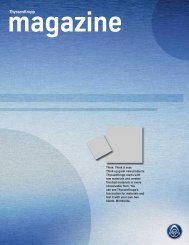Engineering
Engineering
Engineering
Create successful ePaper yourself
Turn your PDF publications into a flip-book with our unique Google optimized e-Paper software.
3.6 Consolidated financial statements Notes to the consolidated financial statements<br />
A complete listing of the Group’s subsidiaries and equity interests is<br />
presented in Note 38.<br />
Goodwill arising on consolidation represents the excess of the cost of<br />
acquisition over the Group’s interest in the fair value of the identifiable<br />
assets, liabilities and contingent liabilities of a subsidiary, associate or<br />
jointly-controlled entity at the date of acquisition. Goodwill is<br />
recognized as an asset and is tested for impairment annually, or on<br />
such other occasions that events or changes in circumstances indicate<br />
that it might be impaired.<br />
Goodwill arising on the acquisition of an associate or a jointlycontrolled<br />
entity is included within the carrying amount of the associate<br />
or the jointly-controlled entity, respectively. Goodwill arising on the<br />
acquisition of subsidiaries is presented separately in the balance sheet.<br />
On disposal of a subsidiary, associate or jointly-controlled entity, the<br />
attributable amount of goodwill is included in the determination of the<br />
profit or loss on disposal.<br />
Foreign currency translation<br />
The functional and reporting currency of ThyssenKrupp AG and its<br />
relevant European subsidiaries is the Euro (€). Transactions<br />
denominated in foreign currencies are initially recorded at the rates of<br />
exchange prevailing on the dates of the transactions. Monetary assets<br />
and liabilities denominated in such currencies are retranslated at the<br />
rates prevailing on the balance sheet date. Profits and losses arising<br />
on exchange are included in the net profit or loss for the period.<br />
Financial statements of the foreign subsidiaries included in the Group<br />
consolidated financial statements where the functional currency is<br />
other than the Euro are translated using their functional currency which<br />
is generally the respective local currency. The translation is performed<br />
using the current rate method, in which balance sheet amounts are<br />
translated to the reporting currency using the rates of exchange<br />
prevailing on the balance sheet date, while income statement amounts<br />
are translated using the period’s average exchange rates. Net<br />
exchange gains or losses resulting from the translation of foreign<br />
financial statements are accumulated and included in equity. Such<br />
translation differences are recognized as income or as expenses in the<br />
period in which the operation is disposed of.<br />
Consolidated financial statements<br />
134 | 135<br />
Companies that manage their sales, purchases, and financing<br />
substantially not in their local currency use the currency of their<br />
primary economic environment as their functional currency. Using the<br />
functional currency in these cases involves translating non-monetary<br />
items such as non-current assets, including scheduled depreciation,<br />
and equity to the functional currency using the average exchange rates<br />
of the respective year of addition. All other balance sheet line items are<br />
translated using the exchange rate as of the balance sheet date and all<br />
other income statement line items are translated using the period’s<br />
average exchange rates. The resulting translation differences are<br />
included in the consolidated statement of income as “Other operating<br />
income or expenses”. Thereafter, the functional currency financial<br />
statements are translated into the reporting currency using the current<br />
rate method.<br />
The exchange rates of those currencies significant to the Group have<br />
developed as follows:<br />
Currencies<br />
Exchange rate as of<br />
(Basis €1)<br />
Sept. 30,<br />
2010<br />
Sept. 30,<br />
2011<br />
Annual average exchange rate<br />
for the year ended<br />
Sept. 30,<br />
2010<br />
Sept. 30,<br />
2011<br />
US Dollar 1.37 1.35 1.36 1.40<br />
Brazilian Real<br />
Chinese<br />
2.32 2.51 2.40 2.30<br />
Renminbi Yuan 9.13 8.61 9.25 9.12<br />
Intangible assets<br />
Intangible assets with finite useful lives are capitalized at cost and<br />
amortized on a straight-line basis generally over a period of 3 to 15<br />
years, depending on their estimated useful lives. Technology resulting<br />
from the acquisition of Howaldtswerke-Deutsche Werft (HDW) is<br />
amortized over a period of 40 years. Useful lives are examined on an<br />
annual basis and adjusted when applicable on a prospective basis.<br />
The amortization expense of intangible assets is primarily included in<br />
the “cost of sales” line item in the consolidated statement of income.

















